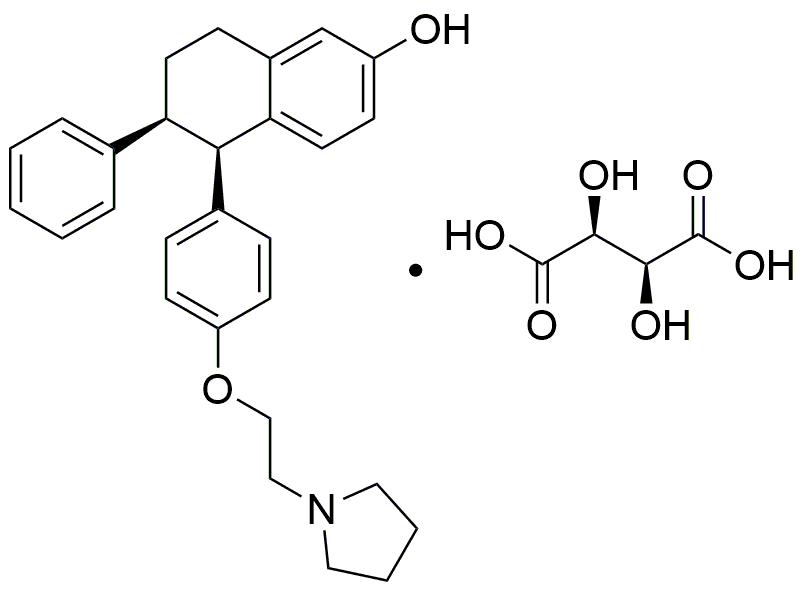Lasofoxifene tartrate is widely utilized in research focused on:
- Bone Health: This compound is studied for its potential to prevent osteoporosis by mimicking estrogen's beneficial effects on bone density, making it a valuable option for postmenopausal women.
- Breast Cancer Treatment: Researchers are exploring its role as a selective estrogen receptor modulator (SERM) to inhibit the growth of estrogen-dependent breast tumors, providing a targeted approach in oncology.
- Cardiovascular Health: Lasofoxifene tartrate is being investigated for its ability to positively influence lipid profiles, potentially reducing the risk of heart disease in women.
- Menopausal Symptom Relief: The compound is evaluated for alleviating symptoms associated with menopause, such as hot flashes, offering a non-hormonal alternative to traditional hormone replacement therapies.
- Research in Endocrinology: Its unique properties allow for studies on hormone receptor interactions, contributing to a deeper understanding of endocrine functions and disorders.
General Information
Properties
Safety and Regulations
Applications
Lasofoxifene tartrate is widely utilized in research focused on:
- Bone Health: This compound is studied for its potential to prevent osteoporosis by mimicking estrogen's beneficial effects on bone density, making it a valuable option for postmenopausal women.
- Breast Cancer Treatment: Researchers are exploring its role as a selective estrogen receptor modulator (SERM) to inhibit the growth of estrogen-dependent breast tumors, providing a targeted approach in oncology.
- Cardiovascular Health: Lasofoxifene tartrate is being investigated for its ability to positively influence lipid profiles, potentially reducing the risk of heart disease in women.
- Menopausal Symptom Relief: The compound is evaluated for alleviating symptoms associated with menopause, such as hot flashes, offering a non-hormonal alternative to traditional hormone replacement therapies.
- Research in Endocrinology: Its unique properties allow for studies on hormone receptor interactions, contributing to a deeper understanding of endocrine functions and disorders.
Documents
Safety Data Sheets (SDS)
The SDS provides comprehensive safety information on handling, storage, and disposal of the product.
Product Specification (PS)
The PS provides a comprehensive breakdown of the product’s properties, including chemical composition, physical state, purity, and storage requirements. It also details acceptable quality ranges and the product's intended applications.
Certificates of Analysis (COA)
Search for Certificates of Analysis (COA) by entering the products Lot Number. Lot and Batch Numbers can be found on a product’s label following the words ‘Lot’ or ‘Batch’.
Número de catálogo
Número de lote/lote
Certificates Of Origin (COO)
This COO confirms the country where the product was manufactured, and also details the materials and components used in it and whether it is derived from natural, synthetic, or other specific sources. This certificate may be required for customs, trade, and regulatory compliance.
Número de catálogo
Número de lote/lote
Safety Data Sheets (SDS)
The SDS provides comprehensive safety information on handling, storage, and disposal of the product.
DownloadProduct Specification (PS)
The PS provides a comprehensive breakdown of the product’s properties, including chemical composition, physical state, purity, and storage requirements. It also details acceptable quality ranges and the product's intended applications.
DownloadCertificates of Analysis (COA)
Search for Certificates of Analysis (COA) by entering the products Lot Number. Lot and Batch Numbers can be found on a product’s label following the words ‘Lot’ or ‘Batch’.
Número de catálogo
Número de lote/lote
Certificates Of Origin (COO)
This COO confirms the country where the product was manufactured, and also details the materials and components used in it and whether it is derived from natural, synthetic, or other specific sources. This certificate may be required for customs, trade, and regulatory compliance.


